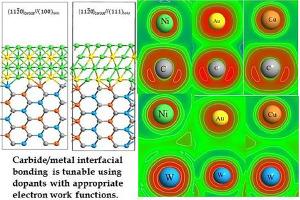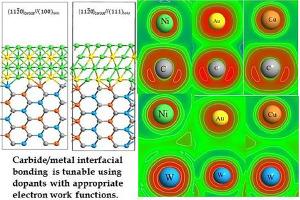电子功函数引导下的(W4-x, Mx)C4 /掺杂镍基体界面键合:第一原理计算的启示
IF 8.3
1区 材料科学
Q1 MATERIALS SCIENCE, MULTIDISCIPLINARY
引用次数: 0
摘要
厚重的碳化钨(WC)可能会导致碳化钨-金属基复合材料硬面覆盖层中的不均匀分布,从而对其作为增强材料的性能产生负面影响。在保持碳化钨强度的前提下,可以用更轻的金属(如钼和铬)部分替代碳化钨。然而,改性碳化钨与基体金属(如镍,一种典型的覆盖层金属基体)之间的粘合情况尚不确定。本文通过第一原理计算,报告了 (W4-x, Mx)C4 (M=钼或铬)与镍基体之间的界面键合研究。通过对电子功函数(EWF)、电子局域函数、电子态密度、键序和净电荷的分析,研究了界面上不同的原子相互作用,即金属-金属和金属-碳相互作用,以了解界面成键情况。研究表明,较轻的(W4-x, Mx)C4 碳化物与镍的结合力很强,与 WC/Ni 界面的结合力相当甚至更强,界面结合包括共价键、离子键和金属键成分。研究表明,可以通过在镍基体中掺入不同 EWF 的元素(如锰、铜、金、铂和硒)来调整界面键合。我们努力验证了一个假设,即 EWF 是一个指标,可用于指导选择有效的掺杂剂来调整界面结合强度。本文章由计算机程序翻译,如有差异,请以英文原文为准。


Electron work function guided tailoring of (W4-x, Mx)C4 /doped Ni matrix interfacial bonding: Insights from first-principles calculations
Heavy tungsten carbide (WC) may cause inhomogeneous distributions in WC-metal matrix composite hardfacing overlays, thus negatively affecting its performance as reinforcement. WC can be lightened by partially substituting W with lighter metals, e.g., Mo and Cr, while maintaining its strength. However, the bonding between modified WC and matrix metals such as nickel (a typical metal-matrix for overlays) is uncertain. This article reports a study on the interfacial bonding between (W4-x, Mx)C4 (M=Mo or Cr) and Ni matrix via first-principle calculations. Different atomic interactions i.e., metal-metal and metal-carbon interactions, at the interface were studied to understand the interfacial bonding through analyses of electron work function (EWF), electron localization function, electronic density of states, bond order, and net charge. It was demonstrated that the lighter (W4-x, Mx)C4 carbides exhibit strong bonding with Ni, comparable to or even stronger than that of WC/Ni interface, and the interfacial bonding includes covalent, ionic and metallic bond components. It is demonstrated that the interfacial bonding can be tuned by doping elements in the Ni matrix with different EWFs, e.g., Mn, Cu, Au, Pt, and Se. Efforts have been made to verify a hypothesis that EWF is an indicator, which can be used to guide selecting effective dopants for tailoring the interfacial bond strength.
求助全文
通过发布文献求助,成功后即可免费获取论文全文。
去求助
来源期刊

Acta Materialia
工程技术-材料科学:综合
CiteScore
16.10
自引率
8.50%
发文量
801
审稿时长
53 days
期刊介绍:
Acta Materialia serves as a platform for publishing full-length, original papers and commissioned overviews that contribute to a profound understanding of the correlation between the processing, structure, and properties of inorganic materials. The journal seeks papers with high impact potential or those that significantly propel the field forward. The scope includes the atomic and molecular arrangements, chemical and electronic structures, and microstructure of materials, focusing on their mechanical or functional behavior across all length scales, including nanostructures.
 求助内容:
求助内容: 应助结果提醒方式:
应助结果提醒方式:


